#East 20th St.
Explore tagged Tumblr posts
Text

The north side of East 20th Street, looking towards 1st Ave., 1938.
Photo: Berenice Abbott via Wikimedia Commons
#vintage New York#1930s#Berenice Abbott#b&w photography#1930s New York#old New York#East 20th St.#vintage cars#city street
45 notes
·
View notes
Photo

Mark Twain
Mark Twain is the pen name of Samuel Langhorne Clemens (1835-1910), an American humorist, journalist, lecturer, and novelist. He was the voice of his generation and one of the most celebrated authors of the late 19th century, writing some of America's best-known and most memorable works of literature: The Adventures of Tom Sawyer, Life on the Mississippi, and The Adventures of Huckleberry Finn.
Through these and other works, he had a profound effect on the development of writing in America, influencing numerous authors of the 20th century, such as Ernest Hemingway (1899-1961). With a career that spanned over four decades, Twain shaped the world's view of America. His rich sense of humor was evident in both his novels and lectures, but Twain's biographer Albert Bigelow Paine believed that he was more than a humorist; he was a philosopher, a prophet, and a humanitarian.
Early Career
Samuel Langhorne Clemens was born in Florida, Missouri, on 30 November 1835. His father, John Marshall Clemens, was educated as a lawyer but chose instead to become a merchant, albeit not a very successful one. In 1839, when Twain was four, his father moved the family to Hannibal, Missouri, a small town along the Mississippi River. In Hannibal, John Marshall returned to the practice of the law, eventually being elected justice of the peace. When he died in 1847, leaving the family in debt, Twain was forced to quit school; he was not quite twelve. Twain, like his older brother Orion before him, was apprenticed to a local printer. When Orion bought a small newspaper, the Hannibal Journal, Twain joined him as a typesetter. The newspaper was operated out of the family's basement. On the days when Orion was absent from the paper, Twain would write small parodies about local characters and conditions, and circulation increased.
In 1853, at the age of 18, Twain left home, working as an itinerant printer in St. Louis, New York, and Philadelphia. By the time he returned from the East, Orion had moved the family to Keokuk, Iowa. Twain would remain in Keokuk with Orion until 1857 when he decided to go to Brazil and the Amazon River. He began the long journey at Cincinnati, working as a printer, until spring. Aboard the Paul Jones, headed to New Orleans, he met a riverboat pilot named Horace Bixby, and after a lengthy conversation, decided to forego the Amazon and become a riverboat pilot. 18 months later, he was considered one the best and most careful on the Mississippi, but, with the outbreak of the Civil War in 1861, the Confederates blockaded the river, stopping all river traffic.
Following a short two-week stint in the Confederate Army, Twain traveled west by stagecoach, hoping to become rich in the silver mines of Nevada. Orion, who had a federal appointment in the Nevada Territory as secretary to the governor, went with him. But with little success as either a miner or prospector, Twain used his free time to contribute short articles to the Territorial Enterprise, a Virginia City, Nevada newspaper owned by John Goodman. It was there that he began to use the name Mark Twain, a river term for two fathoms of water. His new name and humorous articles made him famous along the Pacific Slope. Recognizing his talent, Goodman offered Twain the job as editor of the Enterprise at 25 dollars a week. After two years in Virginia City, he moved to San Francisco where he worked for the Morning Call while contributing to the Golden Era and The Californian.
Continue reading...
53 notes
·
View notes
Text
If there’s one generalization that can stand the test of time, it’s that Jews love pickles. They’re a briny bit of respite from a heavy meal, the snack that solidifies the romantic connection between the protagonists of “Crossing Delancey,” and the hook that keeps people coming back to Sweet Pickle Books — a one-of-a-kind used bookstore at 47 Orchard St. on the Lower East Side that also sells its own line of pickles.
If you’re questioning just how, exactly, one comes up with the concept of a pickle book store — let alone one that’s become an au courant hangout spot downtown — you’re not alone. Founder and owner Leigh Altshuler, a 30-year-old book- and pickle-lover, came up with the idea at the beginning of the pandemic.
“I knew [the store] was going to be books and something and it didn’t have a name, and I knew I wanted it to be after family and being Jewish…and I was just thinking about the lowest common denominator between the two and it was just like..pickles. And that’s where it all began.” Altshuler said.
The idea of opening a used bookstore first hit Altshuler at the beginning of the pandemic. “I really became a big ol’ mushy weirdo about books,” Altshuler said. “I went into Mercer Books which was closing that day in March at 3pm, and I remember a cop came in at, like 2:53, and asked the owner why he wasn’t closed yet. And I was just like, ‘he has time!’”
“I walked home and I just thought it was such a shame that these stores are closing and who knows what’s going to happen,” she said.
A former communications director for New York’s legendary used bookstore, The Strand, Altshuler saw the myriad of empty storefronts across the Lower East Side as an opportunity to set up a shop of her own. After losing her marketing job at the McKittrick Hotel and getting over a breakup in her shoebox apartment, Altshuler opened Sweet Pickle Books in October 2020. It was both a financial gamble and an attempt to honor her personal affinity for the used book industry — a community that felt especially precarious during the height of the COVID-19 pandemic.
As for the pickles, Altshuler and her boyfriend originally experimented with dozens of recipes from during the lockdown by testing out different salt and cucumber varieties until they batched out the first 360 jars — which barely lasted a month. Now, she sources the pickles from a Texas-based farm, and regular customers can swap their book donations for a free jar of branded pickles or buy them separately in store or online, coming in flavors bread and butter, spicy, and dill for $9.50-$12.95.
Which, for operating in a neighborhood that used to be known as the Jewish “pickle alley” in the late 19th and early 20th century, feels perfectly kismet. Altshuler lives about four blocks away in the Lower East Side, and while taking walks during the pandemic saw the empty storefronts and remembered how growing up, relatives told her about the influx of Jewish immigrants that were able to sell and make pickles for cheap in barrels and pushcarts. On the cross street that Sweet Pickle Books is nestled between, over eighty Jewish pickle vendors used to make their living, which is history that Altshuler is very grateful she gets to inform people about for the first time and inadvertently continue the legacy.
“When I first opened, everyone said I was crazy,” she said. “My dad kept on saying to me, ‘Oh, if you do it,’ and I was like, there’s no more ‘if’ here, it’s happening!”
“I don’t even know why I had such a belief it would work,” she added, “but I think it was just a feeling.”
Now, two years out, Sweet Pickle Books is a quirky literary destination for locals and tourists alike — and browsing through the store, it’s easy to see why. The railroad-style aisles are lined with love-worn paperbacks that tend to hover below the $10 mark, a disco ball swings in the corner, and the smooth stylings of the Vince Guardali Trio softly murmur from speakers throughout the store. There’s a pickle costume that young customers frequently take photos in, and big names like Harry Styles and Fran Leibowitz, said Altshuler, have popped in.
To the untrained eye, it may seem like a miracle that a first-time business owner successfully opened a brick and mortar store during a pandemic — let alone one selling actual books amidst a digital culture that mostly obtains information online. Some people think it’s odd that people would even be interested in books anymore, let alone used ones. But Altshuler knows better than that.
“Everyone always asks me, ‘Do people read anymore?’ But book people literally show up and haul books across town because they love it and care about these things,” Altschuler said. “[Sweet Pickle Books] just became the lowest common denominator where people could go for a low price tag and have a real conversation about something.”
Growing up in a heavily Jewish suburb in South Florida where she regularly cruised around the JCC, Altshuler always considered both her culture and religion an innate part of who she is and how she moves about the world. “I basically had no idea that people weren’t Jewish because that’s just where I was from,” she said. “My boyfriend is from Australia and he had no idea that you get a bowl of pickles with your meal at a diner, and I thought every restaurant in the world had that.”
Altshuler still proudly self identifies as Jewish, and running a business in the ancestral heart of Jewish history has only made her connection to her heritage even stronger. “I think [Sweet Pickle Books has] connected me to faith in ways I didn’t really expect,” she said. “I’m understanding the themes in different ways, and seeing the importance of passing tradition on. And so much of that is centered around food, but also stories — and storytelling is exactly what a bookstore is. I feel like it just makes sense.”
In this way, Sweet Pickle Books became a conduit for tradition that feels authentic to Jewish customers and accessible for those who would like to learn more. “A customer of mine found out that she was Jewish and came to me on New Years Eve with a babka and a Zabars mug and told me that she wanted to thank me for teaching her so much about Judaism,” she said, “and she was so happy to have a friend to talk to about being Jewish.”
“I just didn’t expect to be that person for someone,” she added. “That’s a really wonderful thing that I feel like my Jewish mother would be doing cartwheels over.”
Incidentally bridging the gap between communities isn’t something limited to Judaism, though, as Sweet Pickle Books is known to attract customers of all creeds — from the older, New York born-and-bred book hagglers that Altshuler lovingly refers to as her “curmudgeons,” to the droves of TikTok tweens in handkerchief tops, hoping to go viral by posting about a crazy new pickle shop. By harnessing the virtues of old school tradition and trendy innovation, “I really do want to be the bridge between the two,” she said.
“Sometimes I just look at the store and I want to cry because it’s so sentimental to me — like, it’s so real and important in New York history,” she added. “So many people don’t know this was a pickling district, and every day, I’m like, how else would these conversations happen? It makes me look up stuff, and I feel very special that I get to tell people.”
20 notes
·
View notes
Text

Today In History
Jackie Joyner-Kersee is one of the greatest track and field athletes in American history. Born March 3, 1962 in East St. Louis, Illinois, Jackie Joyner-Kersee is the first American woman to win an Olympic gold medal in the long jump and the first woman to compile more than 7,000 points in the seven-event heptathlon.
Joyner-Kersee went on to win three golds, a silver and two bronze medals over four separate Olympics. She was named Sports Illustrated for Women’s top female athlete of the 20th century.
CARTER™️ Magazine
#jackie joyner kersee#carter magazine#carter#historyandhiphop365#wherehistoryandhiphopmeet#history#cartermagazine#today in history#staywoke#blackhistory#blackhistorymonth
48 notes
·
View notes
Text




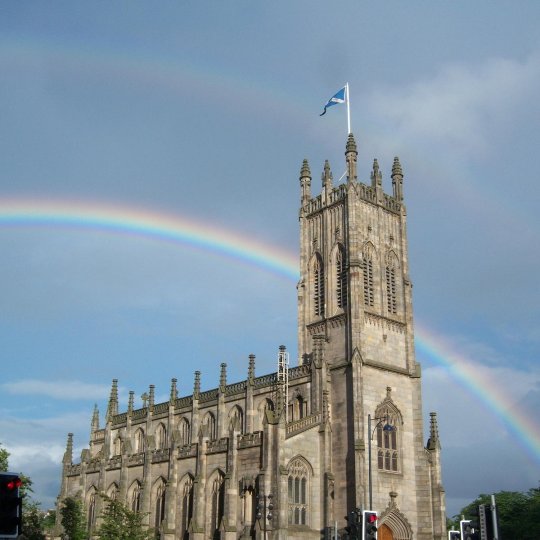
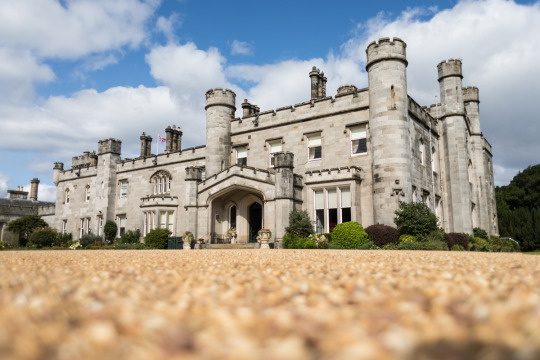
20th December 1789 saw the birth in Edinburgh of William Burn, the architect who pioneered the Scots Baronial style.
Burn was educated at the High School in Edinburgh's Old Town. He started working in Robert Smirke's office in London , before returning to Edinburgh to work with his father, Robert Burn, the designer of the Nelson Monument on Calton Hill.
William Burn's earliest commissions were for public buildings Custom House, Greenock,as seen in the second pic, the Ledoux-like Gasworks at Tanfield, Canonmills, County Hall, Inverness and many others, but his large and phenomenally successful practice consisted mainly of commissions for country-houses. Blairquhan, Ayrshire(pic three), is an example of his Tudor Gothic style.
By c.1825 Burn was designing in a Jacobethan manner that became his speciality. Scottish vernacular architecture and tower-houses were added to his sources from 1829 Faskally, Perthshire, and Tyninghame House, East Lothian (pic four), but, from his completion of Salvin's great Harlaxton Manor, Lincs. (from 1838), his work became more ebullient, leading to his best houses, including Falkland House, Fife, Whitehill Hall, Midlothian , and Revesby Abbey in Lincs.
Although enormously prolific, it is said that Burn perhaps never quite rose to great architecture: his work was described as “competent, very often agreeable, but sometimes veered towards the dull”. He took his nephew, J. MacVicar Anderson, into partnership, who continued the practice after Burn's death. I also noticed that David MacGibbon, of MacGibbon and Ross also worked with him.
Other major works Burn designed were St John’s Princes Street, Edinburgh, (pic five) and Dundas Castle in Midlothian.(pic six), which to me are anything but dull.
8 notes
·
View notes
Text


Green Day American Idiot [20th Anniversary Edition Half Speed Mastering] 2024 Reprise ——————————————————————— Tracks LP One: 1. American Idiot 2. Jesus of Suburbia I. Jesus of Suburbia II. City of the Damned III. I Don’t Care IV. Dearly Beloved V. Tales of Another Broken Home 3. Holiday 4. Boulevard of Broken Dreams 5. Are We the Waiting 6. St. Jimmy
Tracks LP Two: 1. Give Me Novacaine 2. She’s a Rebel 3. Extraordinary Girl 4. Letterbomb 5. Wake Me up When September Ends 6. Homecoming I. The Death of St. Jimmy II. East 12th St. III. Nobody Likes You IV. Rock and Roll Girlfriend V. We’re Coming Home Again 7. Whatsername ———————————————————————
Billie Joe Armstrong
Tré Cool
Mike Dirnt
* Long Live Rock Archive
#Half Speed Mastering#GreenDay#Green Day#Billie Joe Armstrong#Tre Cool#Mike Dirnt#American Idiot#Reissue#20th Anniversary#Punk#2024
8 notes
·
View notes
Text
okay i couldn't wait and started reading the little family info dump before i finished my own research and lol i was missing a brother sorry archibald!!!!! for anyone interested in the little family, plz plz go look at the cold boys research central :D
i can't overstate how happy i am to be reading this, it's like getting a present! not only i feel self satisfied bc all things considered i did a pretty good job :) but i get more info!!!! like ohhhhhh that's where the children's names come from! also it took me until today that literally THREE of edward's relatives are called "cornelius hater" this is hilarious. I also didn't find the James C fleeing on horseback element in my own research and frankly? truly a mad lad this one
a couple things that i found interesting in my own search, but full disclaimer i didn't crosscheck this stuff nearly enough, so there's always the risk that it's just someone of the same name and similar enough location/dates.
The UK Poll Books and Electoral Register for 1834 lists Simon Little as owner of Fleetland Farm and a Mr. Edwards as his tenant, if i understood properly!

now the whole reason why i looked into this is blantantly to imagine more of my blorbo's life so here's stuff that made me go :'o
Edward starts as an officer on the HMS Donegal, in 1837. He's 26 yo! and his younger siblings are 22 (Charlotte), 20 (Archibald), 18 (Richard), 15 (Ridley) and just 13 for Janet! Jane Elizabeth, the eldest, is 35 for comparison.
So in the 1841 census, listed as living in the same house are both parents, Jane Elizabeth, Sarah Magdalen, Margaret Anne, Charlotte and Louisa. Like the info dump points out, none of sons are listed as living with them. What were they doing at the time?
Eldest son James Cornelius enlisted on the HMS Asia in 1828 (at 21), but by 1841 he's on the HMS Beacon as Paymaster just like dad. He also signed up for the freemasons in 1943 in malta! Very exotic
i didn't look up archibald bc i didn't know he existed at the time!
Couldn't find anything on Cornelius Hayter, Edward's closest in age brother, except birth and death dates unfortunately, and he's listed as living on Ker Street in Devonport, (same place as his family in 1941) on his burial record the very next year :(
His death was listed in april may or june of 1842 (i did find his burial records but i can't read the month listed as his death :/).
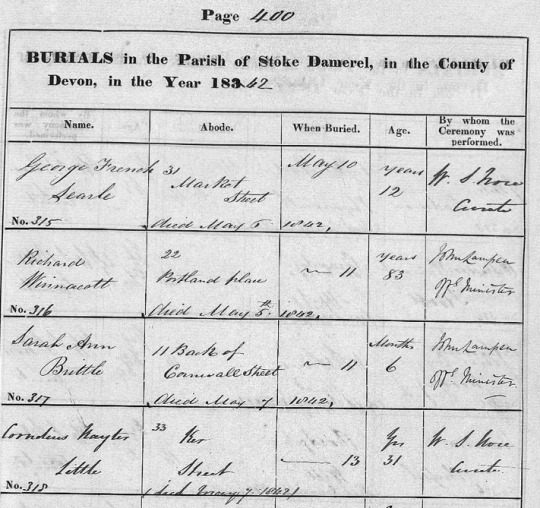
That's during Edwards' time as a lieutenant on the Vindictive (1 year 6 month and 1 day!). I found (with difficulty like damn) the following info on whatever the fuck the vindictive was up to during this time :
"[NICOLAS, JOHN TOUP (1788–1851) commanded] the Vindictive, on the East India station, from 1841 to 1844, returning to England by Tahiti, where he was sent to protect English interests during the arbitrary proceedings of the French (Ann. Reg. pt. i. p. 256)."
However Edward, who finished his posting on the Vindictive on the 20th of oct 1843, might have not seen tahiti!
[nevermind all that about the vindictive, i found a very thorough source thanks to the cold boys research center HOWEVER edward isn't nominatively mentioned as one of her officers so maybe i got his posting wrong?]
Richard John Strachan, his first little brother, is listed as living in the St Helier District General Hospital and Workhouse in the 1851 census when he's 31 yo. His family lives in the same town, so that means that he was ill enough to stay at the hospital full time.
He's listed as a "boarder" and his profession as "annuitant", which is understand as meaning that he recieves money each year, and which is the same thing several of his unmarried sisters are listed as in censuses. on that same page of the hospital census, several people are listed either as "pauper lunatic" and "pauper idiot" (compared to his "boarder") which makes think he was a long term (pure speculation) resident, but for a physical illness? i should look at the 1861 St Hélier Hospital census to see if he's still listed as a resident there, and if i don't find him, try to find his burial because i never found any death info for him, nor a naval career of any sort. mystery!
and lastly, the babiest brother Simon Ridley was a 2nd lieutenant in the royal navy but posted at the Plymouth Headquarters in 1841.
another thing of interest is that out of his 6 sisters (six!!!!), only 2 married :o
As the info dump details, Margaret Ann married a commander who later made captain. she's listed as 28 on her marriage certificate but she was actually 34 lol
and the babiest sister Janet married a commander also, at the respectable age of 51 and the guy got promoted up to vice admiral :o in 1881 when they were living with his adult son from a previous marriage, they had both a cook and housemaid! when she died at 85 yo, she left part of her effects to Alice Maud, her spinster niece (one of margaret's daughters!)
both married sisters had navy husbands, and it made me wonder how they met, like was margaret's husband serving with her older brother? or they were introduced at a navy function while her baby brother was trying to get a good commission? very jane austen
anyway thank you to the person who compiled all this neat info on the little family AND thank you to tumblr user noughticalcrossings who replied to my post with the cold boys research center!!!
6 notes
·
View notes
Text

Tunnleton This is a westbound Baltimore & Ohio train moving through the East Fork White River Valley in southern Indiana. The small burg of Tunnleton lies above the tracks on the hill. This B&O line, between Cincinnati and St. Louis, began life as the Ohio & Mississippi. Apparently, the town was created in the mid-1850s when the line was being built—it lies halfway between Big Tunnel and Little Tunnel. The former still exists while the latter was daylighted just prior to the turn of the 20th century.
While this is the B&O, the motive power is of the Chesapeake & Ohio, part of the Chessie System. Both appear to be SD40s.
Image by Richard Koenig; taken October 28th 1977.
#railroadhistory#railwayhistory#b&o#c&o#baltimore&ohiorailroad#chessiesystem#tunneltonindiana#tunneltonin#tunnleton#chesapeake&ohio
48 notes
·
View notes
Text

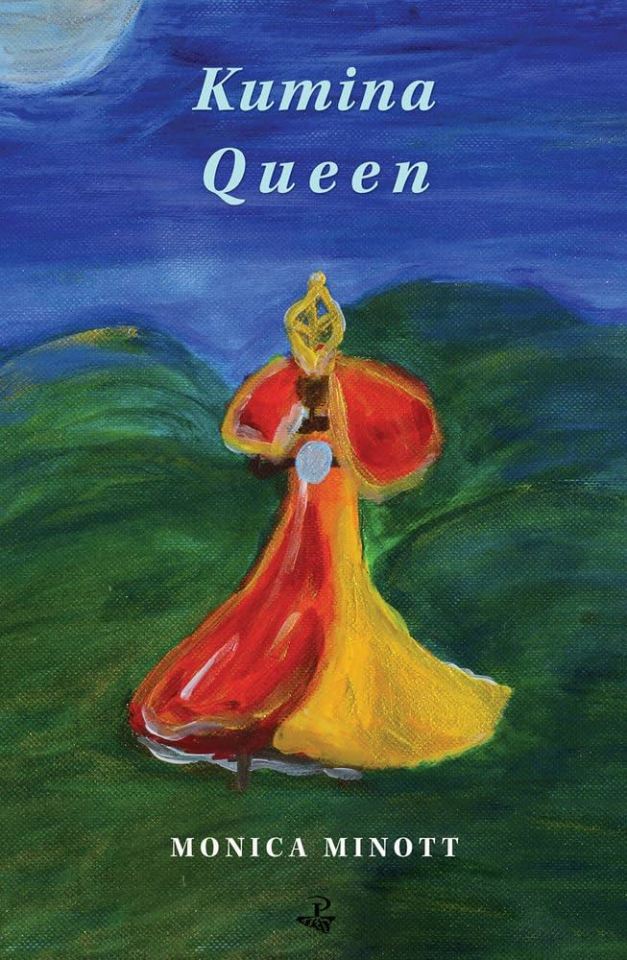
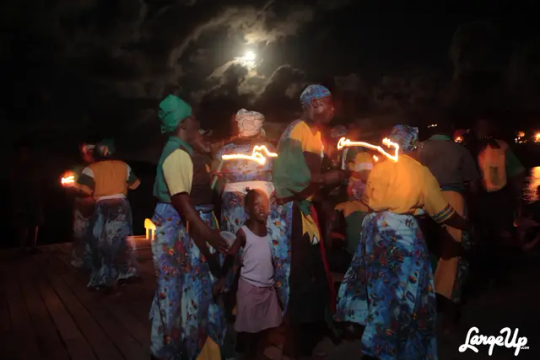
Kumina is an Afro-Jamaican religion. Kumina has practices that include secular ceremonies, dance and music that developed from the beliefs and traditions brought to the island by Kongo enslaved people and indentured labourers, from the Congo region of West Central Africa, during the post-emancipation era. It is mostly associated with the parish of St. Thomas in the east of the island. However, the practice spread to the parishes of Portland, St. Mary and St. Catherine, and the city of Kingston.

Kumina also gives it name to a drumming style, developed from the music that accompanied the spiritual ceremonies, that evolved in urban Kingston. The Kumina drumming style has a great influence on Rastafari music, especially the Nyabinghi drumming, and Jamaican popular music. Count Ossie was a notable pioneer of the drumming style in popular music and it continues to have a significant influence on contemporary genres such as reggae and dancehall.
The Kumina riddim is a dancehall riddim produced by Sly & Robbie in 2002. It has featured in recordings of over 20 artists including Chaka Demus & Pliers and Tanya Stephens.

Kumina is an Afro-Jamaican Religion and is not the same as Pukkumina or Pocomania.
Kumina emerged through the practices of indentured labourers who were brought to Jamaica from the Kongo region of central Africa after the abolition of slavery. In the second half of the 19th century it syncretised with Myalism. Kumina differed from Zion Revivalism in rejecting the belief that the Bible should be the central authority behind worship.
The practices of Kumina are primarily linked to healing.[4] Healing ceremonies utilise singing, dancing, drumming, animal sacrifice, and spirit possession, with the intent of summoning spirits to heal the sick individual. These elements are also found in Myalism and Zion Revivalism.
Organization of Kumina communities follows the general local character of African religions in Jamaica. Kumina communities are small family based communities or nations. Some nations include Mondongo, Moyenge, Machunde, Kongo, Igbo, and Yoruba. People from Kumina families are given the title Bongo. Marrying into a Bongo family is one avenue to become a part of a Kumina nation; special initiation is the other avenue. Kumina nations are led by a "King" and "Queen". Imogene "Queenie" Kennedy AKA Queenie III (c1920-1998) was a well-known Kumina Queen in the 20th century, born in St Thomas in the late 1920s she later moved to Kingston and then Waterloo, St Catherine.


The use of cannabis or ganja in Kumina may have been an influence on the adoption of this plant as a sacrament in Rastafari, a religion that developed in Jamaica during the 1930s.
#kumina#afro jamacian#jamaican#rastafari#african#afrakan#kemetic dreams#africans#brown skin#afrakans#african culture#afrakan spirituality#brownskin#rasta#rasta love#dancing rasta#rastaman#kisumi amau#impulsesv#tegan and sara#sexy nerd
16 notes
·
View notes
Text

David Lodge
Booker prize-nominated author and critic who was known for his Catholic novels and satires on academic life
David Lodge, who has died aged 89, was, like his close friend Malcolm Bradbury, a professor of English literature who became even better known as a novelist. The two men occupied adjacent offices for some years at Birmingham University in the early 1960s and greatly influenced each other. Both were grammar school boys from non-academic backgrounds who became leading figures in English letters without ever darkening the gateways of Oxford or Cambridge universities. Both wrote novels in part out of an instinct to reach a wide constituency of readers with literary tastes.
Lodge worked briefly for the British Council before getting his first academic job in 1960, as a lecturer in English literature at Birmingham. In the same year his first novel, The Picturegoers, was published. This and the novel that followed, Ginger, You’re Barmy (1962), were written under the influence of Graham Greene, a fellow doubting Roman Catholic novelist whom the young Lodge much admired. Lodge’s own PhD, The Catholic Novel from the Oxford Movement to the Present Day, had examined the genre to which he himself began to contribute.
The protagonist of The British Museum Is Falling Down (1965), Adam Appleby, agonises over the rights and wrongs of contraception, and Lodge’s early fiction was clearly rooted in his own scruples and discontents. The novel was also notable for its gift of literary parody: Adam is researching for an English literature PhD and sections of the novel mimic the styles of leading 20th-century novelists. This dexterity was as characteristic a feature of its author as the religious questioning. The subject matter of this and most of his subsequent novels was drawn from his close knowledge of literary academia, and its follies.
David was the only child of a dance-band musician and sometime singer, William Lodge, and was brought up in Brockley, south-east London. His mother, Rosalie, was a Roman Catholic and he was educated at St Joseph’s academy, a Catholic grammar school in Blackheath run by a religious order, the De La Salle Brothers. He went to University College London to read English – he said that he was put off applying to Oxbridge by the impression of it he received from reading novelists such as Evelyn Waugh. From 1955 until 1957 he did national service in the Royal Armoured Corps. The experience would later be used in Ginger, You’re Barmy, which gives a jaundiced picture of army life. He then returned to UCL as a postgraduate.
When he was 24 and still studying for his PhD, Lodge married Mary Jacob, a fellow Catholic, whom he met while both were English undergraduates. Soon the couple had two sons and a daughter. (He would look back with something like amazement at their conviction that they should use only the methods of birth control approved by the church.) The third of their children, Christopher, had Down’s syndrome. He lived at home until he was in his 20s, and his care and education were a central commitment of family life. Lodge was later to raise funds and campaign on behalf of sheltered communities for adults with learning difficulties.
Two formative periods in the US – at the Harkness Commonwealth Fellowship (1964-65), then as a visiting professor at the University of California, Berkeley, in 1969 – animated both Lodge’s academic studies and his fiction. He turned to the campus novel, a genre in which he became a household name. Changing Places (1975) featured Philip Swallow, a bumbling, middle-aged English literature lecturer who is liberated, sexually and intellectually, by an academic exchange with a dynamic American professor, Morris Zapp. As well as exchanging jobs, the two men take up with each other’s wives. Zapp, based on Lodge’s friend Stanley Fish, became his best loved character. The novel won the Hawthornden prize and his widest readership to date.
It was followed by the playfully allusive Small World (1984), which continued Swallow’s and Zapp’s misadventures, and then Nice Work (1988), whose two main characters, a feminist academic and a bluff businessman, enacted the clash between two worlds. Inevitably, they also have an affair. These last two novels were both shortlisted for the Booker prize.
The main location for Lodge’s campus novels was the University of Rummidge, a scarcely disguised version of the University of Birmingham, where he continued to work. The novels reflected the academic fashions of the period, of which he was a slightly hesitant leader. His early criticism, such as his Language of Fiction (1966), showed him applying the close reading techniques of the “new criticism” to classic fiction. This first book was widely read by students and he was soon established as a leading academic analyst of classic fiction.
In the late 1970s, like other literary academics of his generation, he was stirred by the arrival of literary theory in British universities, and his own critical writings changed in response. The first symptom of his new interest was his collection Working With Structuralism (1981). His Modern Criticism and Theory: A Reader (1988) would become a standard anthology for students. He was a pioneer in making the sometimes arcane vocabulary of narratologists accessible to the general reader.
He had a special liking for the work of the Russian theorist Mikhail Bakhtin, whose delight in the novel’s subversive clash of different voices and viewpoints clearly appealed to him. By the mid-80s, however, Lodge’s interest in such theory had waned, and he was later to decide that it was a movement that had exhausted itself.
Thanks to the success of his fiction, by 1984 he was working only part-time as an academic, and in 1987 he retired from his post at Birmingham, though he continued to live in the city for the rest of his life and was made an honorary professor of his old university (and later emeritus professor). He was to admit that his use in his fiction of his observations from his professional life sometimes made colleagues, and therefore himself, uneasy. He remained a critic, however, as well as a novelist. For two years his column in the Independent on Sunday exemplified, for the general reader, the usefulness of particular items of critical vocabulary. Selections were collected in The Art of Fiction (1992).

His campus novels had taken him away from the Catholic themes that he had still been exploring in How Far Can You Go? (1980), which was the Whitbread book of the year. (In this novel Lodge gives one of his leading characters his own experience of having a child with Down’s syndrome.) Paradise News (1991) returned to the territory of religious dogma and doubt, and seemed to announce Lodge’s inexorable move away from religious certainty: its protagonist only achieves contentment by conquering his Catholic hang-ups.
Yet, Lodge’s fiction was not exactly becoming more secular: both Therapy (1995) and Thinks ... (2001) have leading characters on whom Catholicism still has its hold. Lodge had come to describe himself as an interested observer of Roman Catholicism, rather than an actual believer, but his fiction tells the story of a writer still fiercely engaged by Christian themes.
With academia behind him, he entered new territory as a writer. At the end of the 1980s he adapted Small World then Nice Work for television (the former for Granada, the latter for the BBC). He then adapted Charles Dickens’s Martin Chuzzlewit as a six-part BBC serial (1994). If Ulysses was his favourite novel, Dickens was probably his favourite novelist, and his involvement with this dramatisation seemed a logical fusing of his populism and his literariness. He also wrote three plays, including The Writing Game, staged at Birmingham Repertory theatre in 1990 and adapted for television.
His literary tastes were catholic (in the non-religious sense) at a time when literary academics were becoming more specialised. He wrote introductions to the works of authors ranging from Jane Austen and George Eliot to EM Forster and Patrick Hamilton. His critical generosity and sound judgment made him a natural choice to chair the Booker prize judges in 1989. He seems a quintessentially English proponent of a peculiarly English genre – the comic novel – but his work was widely translated. In France his popularity was marked when he was made a Chevalier de l’Ordre des Arts et des Lettres in 1997. In 1998 he was made a CBE.
Ever the trained critic, he was candid in his analysis of his own narrative, confessing that, as a novelist, he had used up much of his own experience by his 60s. His later novels remained literary, but were not necessarily rooted in what he called “phases of my own life”, like the novels that had gone before. So Author, Author (2004) dramatised a period in the life of Henry James, while A Man of Parts (2011) was based on the life of HG Wells. They were biographically impeccable, but made less of Lodge’s gift for comedy than earlier novels. The former suffered the misfortune of being published at the same time as Colm Toibín’s novel about Henry James, The Master. Lodge wrote a rueful account of the coincidence and its consequences in The Year of Henry James, or Timing Is All (2006).
In 2008 he published what was, in many ways, his most autobiographical novel, and one of his best, Deaf Sentence. Lodge had started losing his hearing in his mid-40s. Up to this point, only those closest to him had realised that his partial deafness had deeply influenced him. It contributed to his decision to retire from academia and turned him in on himself. Struggling to keep up with conversations, he said, had stopped him being amusing. Lodge often spoke of his feelings of anxiety, undiminished by literary success or academic standing. Yet the deafness that depressed him in life became comic in his novel.
Admirers of Lodge’s novels were often surprised to find him, in person, dolefully reflective. This was the spirit of his memoir, Quite a Good Time to Be Born, published in 2015. Covering the period from his birth to his breakthrough, at the age of 40, with Changing Places, it gives (despite the title) a glum and minutely circumstantial account of growing up a Roman Catholic in the 1940s and 50s.
Lodge looks back with some amazement at his younger self’s respect for Catholic doctrine. Two further volumes of memoirs, covering later periods of his life, followed. Writer’s Luck (2018), should have relished his middle years of celebrity and success, but is more precise about the small disappointments of his literary life. Varying Degrees of Success (2020), covering the years after academia, lets us know just how wearying the business of writing can be.
His last published work of fiction was The Man Who Wouldn’t Get Up (2016), a collection of short stories mostly composed between the 1950s and 90s. Humorously fable-like, they serve as a reminder of this melancholy man’s comic instinct. Fiction allowed him to combine his literary-critical intelligence with a gift for observing absurdities, in order to fashion his own peculiarly bleak brand of comedy.
Mary died in 2022. He is survived by their three children, Stephen, Christopher and Julia.
🔔 David John Lodge, writer and critic, born 28 January 1935; died 1 January 2025
Daily inspiration. Discover more photos at Just for Books…?
4 notes
·
View notes
Text
The Galician campaign of 1809
Today let me tell you a little bit about the Galician campaign of the Austro-Polish war of 1809, which proved to be a great success for the Duchy of Warsaw.
After the battle of Raszyn there happened the series of small battles, which prevented Austrians from crossing the Vistula, thus leaving the initiative on the right bank of the river firmly with the Poles. So, the Polish forces under Poniatowski’s command moved along Vistula to the South-East, to the lands Austria seized during the latest partition of Poland.
On the 14th of May the Polish Army entered Lublin:
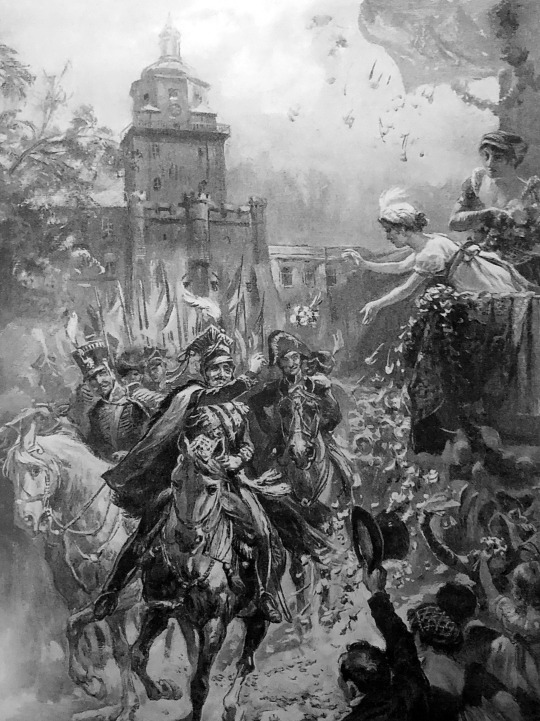
Konstanty Gorski, "Prince Józef Poniatowski enters conquered Lublin in 1809, showered with flowers by ladies"
As Kajetan Koźmian recalls in his memoirs, Poniatowski and his men were greeted with "joy and elation", and in the evening "... the city and the citizens gave a great ball <...> in the house in Korce. Prince Józef honored them with his presence starting the ball."
The next city on the way of the Polish Army was Sandomierz, and after a short siege it was taken on the 18th of May.

Siege of Sandomierz in 1809.
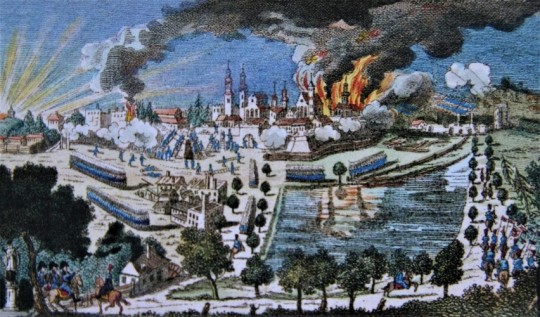
Michał Stachowicz, a scene from the battles in Galicia ("The Capture of Zamość")
Then there was Zamość, where the Polish trooped entered on the 20th of May.
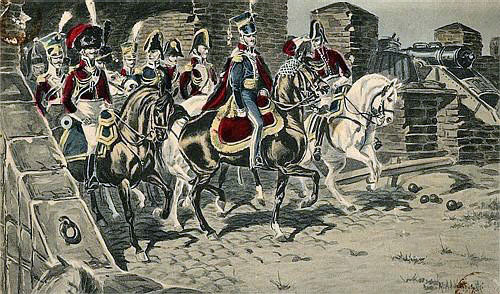
Siege of 1809, M. Adamczewski Entry of Prince Poniatowski to Zamość (postcard)
On the 27th of May the Polish advanced forces even reached the city of Lwów, but prince Józef wasn’t among them.
Meanwhile the Austrians under command Archduke Ferdinand realized the precariousness of their position in the center of Poland, and on the 1st of June left Warsaw for the south.
Poniatowski, for his part, decided not to engage with the Austrian, focusing instead on "liberating” as much Galician land as possible.
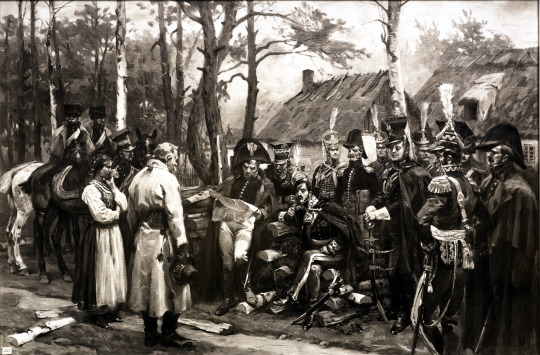
Prince Józef Poniatowski seeks information from local peasants in Galicia in 1809, a photo of Stanisław Bagieński's painting
On the 3rd June there appeared the third participant of the events - Russian forces crossed the Austrian border to Galicia as well. And though formally they were acting as Napoleon’s ally, as was prescribed in the Tilsit Treaty, their real goal was to prevent the Poles from taking too much of the Austrian-held territories.
So, to outwit the Russians prince Józef was taking Galician cities not in the name of the Duchy of Warsaw, but in the one of emperor of the Frenchmen. Like the proclamations were being made in the name of Napoleon, the eagles on the coats-of-arms replacing the Austrian ones were not Polish and French etc.
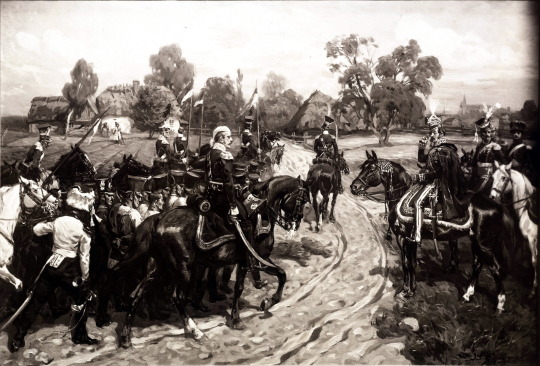
Lancers lead Austrian prisoners of war near Kraków in 1809, in front of Prince Józef Poniatowski, a photo of Stanisław Bagieński's painting
Then, in the outer theater of war on the 6th of July the French defeated the Austrians at the Battle of Wagram. And according Franco-Austrian truce signed five days later the land division was to take place along the line where the troops were at the time of receiving news of the truce, not at the time its signing.

The Austrian army leaves Wawel, a postcard based on the painting of Wojciech Kossak
And so began the race between Russians and Poles, to advance to as farther as possible.
In the middle of July both armies reached Kraków.

PRINCE JOSEPH'S ENTRY TO KRAKOW. A drawing by Jan Feliks Piwarski.
And there the clash of the interest took place.
Poniatowski approached the city from the side of St. Florian's Gate, but it turned out that the Austrians, wanting more comfortable terms of capitulation, had already let Russian troops into Kraków.
The Russians, namely the Cossacks of General Sievers, wanted to deny Poniatowski passage. But Prince Józef, as Dezydery Chłapowski recalls in his memoirs, "draw his broadsword and with together his staff galloped into the gate through the Cossacks". The Polish infantry followed its commander "in a double step <...> so that the Cossacks were pressed against the walls of the gate." Seeing this, Mariampol's hussar regiment, which was stationed at that time in the market square, make a decision to put up resistance and due to this, the whole Polish army was able to enter the city.

Michał Stachowicz, The entry of Prince Józef Poniatowski into Krakow on July 15, 1809
Then, as Ambroży Grabowski recalled, when prince Józef’s troops reached the market square, “in front of the church of St. Wojciech, the magistrate went out to meet the prince, to give him the keys of the city”.
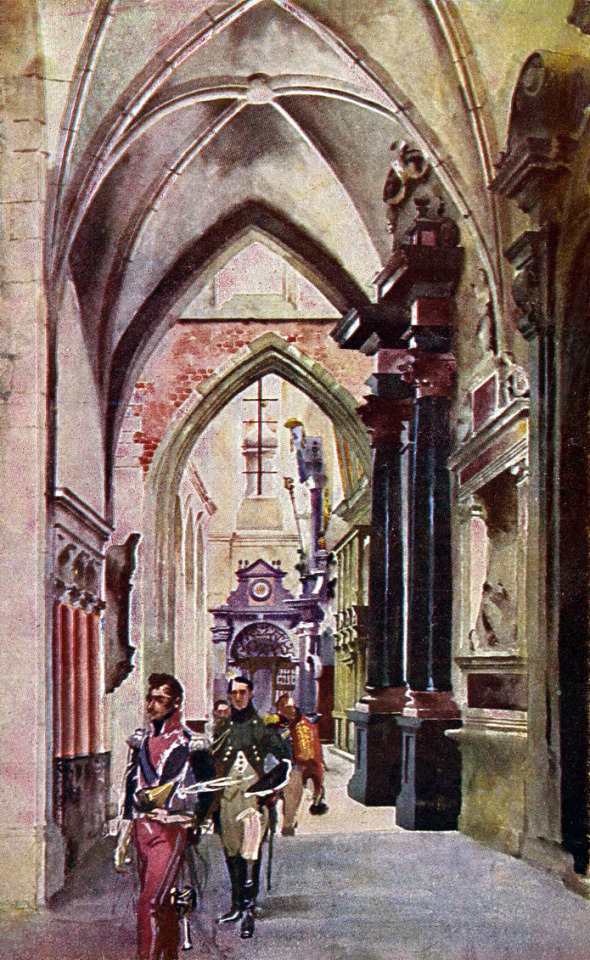
Józef Poniatowski in the Cathedral after Kraków was taken from the Austrians, an image by Stanisław Tondos and Wojciech Kossak
Most probably prince Józef visited the Wawel cathedral during his sojourn in Kraków that time. (In a small voice: little did he know that in 8 years he’ll be buried there...)
And after exactly a month since the Polish troops entered Kraków, there was a ball arranged in the Cloth-hall, the image depicting it I have already posted here.
#Poniatowski#Jozef Poniatowski#józef poniatowski#1809#Galicia#Lublin#Sandomierz#Zamość#Kraków#Austro-Polish War#Konstanty Gorski#Michał Stachowicz#Stanisław Bagieński#Wojciech Kossak#Feliks Piwarski#Kajetan Koźmian#Dezydery Chłapowski#ambroży grabowski
34 notes
·
View notes
Text
Some of you may remember me making a post a while back about "urban dark Abrahamicana". Well, now I've gone and made a setting for that aesthetic.
This will be a long post. Tagging @idylls-of-the-divine-romance because I think you'll like it.
The City of Bevel-on-the-Water

(Sorry for the poor quality of the image; that's the lighting in my room. Try turning up the brightness of your screen to make it clearer).
History
Bevel-on-the-Water was founded in the 13th century in northern Lincolnshire atop Bevel Carr, an alder carr that is now reduced to a few fragments. The town remained a minor settlement for several centuries, before expanding in the late 18th century with the Industrial Revolution, with the several rivers passing through it and its location between the coalfields of Yorkshire and the economic centres of the southeast making it a valuable transport artery, and continued to grow and prosper thanks to adopting rail technology.
The town has been less fortunate in the 20th and 21st centuries. In the Second World War, it was a target for German bombing raids, and much of it had to be rebuilt. Combined with the closure of coal mines and privatisation of railways in the 1980s, and the city spent the last quarter of the 20th century and the first decade of the 21st as a shell of its former self.
However, from the 2010s onwards it has been improving economically; the rock-bottom rents and proximity to important locations make it a popular place for young graduates and immigrants; in particular, the area is a popular "staging post" for Bulgarian and Romanian immigrants, who spend a few years working here before accumulating enough money and experience to move somewhere more upmarket.
And most are very eager. The history above can be found in history books; the history that the people of the East Midlands and Yorkshire would recognise it for is not found in those, but in folklore collections, internet forums and, above all, stories on the streets. Some of it will be related below.
Areas of the Town
Bevel-on-the-Water Halting Site
The trailer park located on the south bank of the town, filled with caravans and campervans atop litter-strewn stretches of tarmac and sickly grass housing not just the city's unusually large Romani population and various other poor people but stranger things as well; caravans home to itinerant occultists, tents home to demoniacs, shadows dancing in the night. The aforementioned Romani are well-established here, and hence are unusually well-liked and prosperous.
City Centre
The old medieval centre - albeit now mostly consisting of neo-Gothic architecture with substantial Brutalist additions - of the town, containing both the Town Hall and Bevel University, a university founded in the 1920s and shuttered in 1994, with much still inside it, including a great many ancient and esoteric texts rotting inside its crumbling Neo-Gothic library.
Eastwalk
Eastwalk is a small suburb on the east bank of the city, near the edges. While as impoverished and decrepit as the rest of the city, it is notable for having an active Anglican community (based around the city cathedral, St. Michael's Cathedral) and almost none of the macabre legends attached to the rest of the city. Other Christians, most notably Methodists from a major campaign conducted here in the 19th century, are also here.
Greensford
A large and particularly declining neighbourhood, located in the southwest of the city. The decay affecting almost everywhere here is particularly acute in this neighbourhood - ivy smothers abandoned buildings, dandelions and brambles carpet streets, and half-feral children spend their days playing in the adjoining woods and swapping stories of sorcery, ritual murder and even cannibalism - many of them true.
Ironfields
The centre of economic activity during the city's industrial heyday (and still containing its train station), and an exemplar of its decline today. Everywhere one turns are crumbling houses, shuttered factories and graffiti. Only people who bother (or dare) to spend time there see what lurks beneath; the saints and crucifixes adorning the hearths and doorposts of inhabitants, the se'irim dancing inside the factories and seen only out of the corner of the eye, the graffiti proclaiming "Satan lives" and "Jesus Christ conquers" in equal number.
Johnstow
The smallest of the neighbourhoods of the city, located south of Eastwalk. The main characteristic of this neighbourhood is the great number of junk shops and second-hand bookshops, which become noticeable, like everything else, upon closer inspection - the bookshelves contain The Hypostasis of the Archons and the Nisibene Hymns, the shops sell icons and censers and the like. The most notable one, Johnstow Books, has a mysterious proprietor - John Egapus, an extremely ancient Near Eastern man who seems to have been doing his job as long as anyone can remember.
Mortlake Heath
Mortlake Heath is the richest neighbourhood of the city, with an abundance of genteel 18th century houses and statues in the street and a shortage of children due to most of them going to private school; however, almost all of them eventually return to Bevel-on-the-Water or vanish. Again, a little look behind closed doors is a walk into darkness - candle-lit rituals in basements and attics, occult books hidden under the covers behind mundane ones, pentagrams and sigils drawn on the walls of rooms that the inhabitants think visitors won't go into.
Northgate
Northgate displays openly what the rest of the city thinly veils. Hardly a street lacks a portrait of Baphomet or an inverted pentagram, and everyone here has seen a ritual with inverted crucifixes and people dressed in black. Bloodstains are also not hard to see, and everyone dreads going into this district of the city - few people in Lincolnshire or South Yorkshire have not heard stories of occult murder or demon-summoning associated with here.
Oldstreet
West of Eastwalk, Oldstreet is another strong representative of the city's decline. A 19th-century suburb that never recovered from Second World War bombing, every turn here shows a burnt-out building or a rotted house, and the few people still living here are old and haunted. The most famous site of destruction here, St. Paul's Chapel, is a burnt-out church with the floor carpeted in thorns and a single crucifix shining amidst the rubble.
Southgrove
Southgrove, to a passer-by, looks like a pristine town - all hedgerows and suburban housing and smiling families. The town keeps its secrets well, but not infallibly - all those who research find that self-harm, domestic abuse and alcoholism run rampant here. Deeper research finds yet more things; sigils drawn in the margins of books, rites conducted in the school basement, books of magic in the library.
Stonewater
Stonewater represents the 20th century rebuilding project; a great mass of concrete towers and blocks where people live, perpetually bathed in mist and rain. This is where most people live, and is no less accursed than elsewhere, having its fair share of stories of Satanic sacrifices and sorcery, along with tales about mysterious strangers and visitations from Heaven.
Westcourt
Westcourt is where the city's immigrant community has always lived; Irish in the 19th century, Eastern Europeans today. As such, it has a large number of Roman Catholic and Orthodox churches, as well as plenty of dark myths. Few people live here for long, with most moving from one of the many cheap flats to a more prosperous town as soon as possible.
Forests
Bevel Carr: The primal forest of the city, now reduced to three pateches in the north, east and west, with ravens croaking and warblers piping amidst waterlogged meadows of ferns and mead wort, mist rising up amidst the clusters of alder, willow and birch and the wind singing mournfully.
Bevel-on-the-Water Tree Plantation: The tree plantation is a large and gloomy forest of spruce, planted after the Second World War in the hope of providing jobs. The plan largely failed, but the expanse continues to carpet the western edge of the city, and provide the backdrop to dark myths; everyone has heard of the human sacrifices atop Hanger Hill on May Eve and Halloween, or the revenant who lurks in an abandoned maintenance shed, or the spirit of the elder oak remaining from the previous forest.
Johnstow Woods: Outside the town of Johnstow lies the woods that give it its name; a hollow filled with hawthorn and rowan, centred on the tomb (or stow, in Old English) of the 9th-century abbot who lived here inside St. John's Chapel, a small Anglo-Saxon church.
Demographics
Total Population: 264,900
Ethnic
White British: 74.2%
Bulgarian: 9.8%
Romanian: 6%
Black British: 4.2%
South Asian: 2.8%
Romani: 2.2%
Other: 0.8%
Religious
Non-Religious: 58.2%
Anglican: 11.8%
Orthodox: 10%
Methodist: 9.6%
Pentecostal: 5.4%
Roman Catholic: 2%
Islam: 2%
Hindu: 0.8%
Other: 0.2%
4 notes
·
View notes
Text
George W. Maher, architect - part 1
Hutchinson Street District, Chicago
Unless otherwise noted, photographs are by Roger Jones

George Maher in the 1890s (Kenilworth Historical Society)
George Washington Maher (December 25, 1864 – September 12, 1926) was an architect who worked in the United States mainly during the first quarter of the 20th century. Maher was noted for his designs in the Prairie Style, and in his time was often more well-known than his contemporary Frank Lloyd Wright.
Maher was part of a new movement in architecture that sought to establish a distinctive American style. East Coast architect Henry H. Richardson had garnered attention by designing monolithic stone buildings. In Chicago, a new architectural style was emerging. Variously labeled as “The New School of the Midwest,” “Rationalism” or “Chicago Style,” it is today known as the Prairie School.Many young architects had begun their careers together and were inspired by Richardson and Sullivan. Maher, George Elmslie and Frank Lloyd Wright had worked together in the office of architect Joseph Lyman Silsbee, whose influence can also be seen in their work. Evanston Roundtable
Maher is well-represented in Chicago, notably in the Hutchinson Street District, and found early success in Oak Park, as well as in Kenilworth, where he lived.
This post focuses on five houses he designed on Hutchinson Street, and includes links to interior photos and historic images.
Mosser House, 750 W. Hutchinson St., 1902

The facade of the Mosser House isn't easily seen from the street. Photo: Zillow



Exterior views
This house was designed by George W. Maher in 1902, and sits on 6 city lots of private landscaping, designed by landscape architect Jens Jensen. The home's interior features details crafted by designer Louis Millet, who also designed the stained glass Tiffany dome in the Chicago Cultural Center. The home is located in the former Scales parcel (see Scales house below).




Above floor plans and fireplace views courtesy of Pricey Pads. Click on link for extensive views of the house.
Willliam H. Lake House, 832 W. Hutchinson St., 1904

Front view



Above: images from the Inland Architect and News Record, Vol. XLVI No. 3, Oct. 1905
W.H. Lake was a grain broker and senior partner in the firm of W.H. Lake & Company which was located in the Board of Trade Building. Lake, following the lead of his neighbor, John Scales, chose to commission George Maher as architect for his home, which was constructed in 1904. In the Lake House, Maher developed his final version of the Farson House (1897) type. In this type of design Maher made his most significant contribution to the indigenous American architecture he worked so hard to develop. Unity is achieved by formal arrangement of elements within the design. The basic form of this house type is a massive rec- tangle with horizontal elements dominating the composition and drawing it together. Hutchinson Street District, City of Chicago Landmark Designation Reports
Images of the interior an be found on the real estate site here.
Seymour House, 817 W. Hutchinson St., 1913



The house at 817 Hutchinson was designed by George W. Maher and constructed in 1913 for Claude Seymour. Drawings of the front facade were published in the Chicago Architectural Club Catalog for 1913. Seymour was a vice-president of Otto Young and Company, an upholstery business. Like many of his neighbors, Young was active in the Chicago Automobile Club and a member of many other fashionable clubs.
In his design for the Seymour House, Maher borrowed heavily from English country houses by C.F.A. Voysey and the firm of Parker and Unwin. The two-story house is basically H-shaped, though a one-story porch (not an addition) does break the symmetry of the facade. The many windows and their arrangement here are typical of Parker & Unwin's designs, but the geometric pattern in the leaded glass is distinctly the work of Maher.
This design and its variations are used consistently in all decorative elements to lend a measure of continuity; Maher called it his motif-rhythm theory.
City of Chicago Landmark designation Reports

Image from The Western Architect, March 1914
Images of the interior an be found on the real estate site here.
John C. Scales House, 840 West Hutchinson Street, 1894


John C. Scales came to Chicago with his parents in 1845 when he was just 4 years old, and his father set up a commission business in town, where John eventually became a partner. Scales, the son, invested his money in real estate and purchased a section of the Buena Park subdivision on the city's then remote north side. Chicago designslinger
The Queen Anne style and busy roofline contrast strongly with Maher's later designs along Hutchinson St. The rough-cut stone along with half-timber design is almost playful.

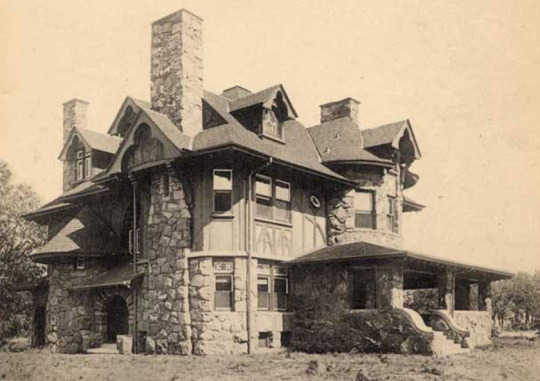
Archival photo of the Scales House
Brackebush House, 839 W. Hutchinson St., c. 1909-10

Maher designed this home in 1909 for Mrs. Grace Brackebush.
Despite the rather awkward handling of certain elements in the design of the house at 839 Hutchinson Street certain experts feel that the design is the work of George W. Maher. The design probably dates from the period between 1905 and 1910, when Maher was beginning to work with a new type of design, one that was inspired by English architects such as C.F.A. Voysey and the Viennese architect Joseph M. Olbrich. - Hutchinson Street District, City of Chicago Landmark Designation Report

Images of the interior can be found on the real estate site here
Sources:
City of Chicago Landmark Designation Reports, Hutchinson Street District, Revised Summary of Information September 8, 1975, Commission on Chicago Historical and Architectural Landmarks
Geo. W. Maher, a democrat in Architecture. The Western Architect, March 1914
George W. Maher's Prairie Style. Owlcation.
Four Architectural Gems in Chicago's Buena Park for Sale. Chicago Magazine.
Buena Park Neighbors, History of Hutchinson Street.
The George W. Maher Society, About George W. Maher.
Block Club Chicago, Want to Own a Piece of Chicago's Past?
Evanston Roundtable - George W. Maher
#George W. Maher#architecture#chicago#buildings#photography#Maher#Hutchinson St.#residences#prairie style
5 notes
·
View notes
Text
Wednesday 20th November 2024
A night containing some amount of rain, but fine at sunrise. The weather is a little weird with the East Coast wetter and cooler than usual. Here in Julia Creek, it would be expected to be in the mid forties as it has been for us further back. Yesterday, it was only 35, and whilst the locals are appreciating these low temperatures, one was saying that the more normal higher temperatures kick off the storms that clear the air. I guess you can't have it all. The tradie in the next unit is working on the railway clearing bush. He said he likes the cool 35. Did I mention the railway? The Mount Isa to Townsville line passes our chalet, probably 80 meters away. A narrow gauge line that carries kilometre long freight, mainly from the mines, but also a couple of passenger trains a day to the coast. Is this an interest or a nuisance?
Our accommodation, once again in trendy GWR livery, brown and cream, possibly painted at about the same time as the last steam train pulled out of Stogumber due to Beeching cuts. Due a paint job I think. The rest of the clientèle are employed by the railway or mines, and so are unlikely to make negative comments on TripAdvisor. By 7.30 the rest of our block had gone to work. We had a long conversation with a chap on his way to his work, which seemed to involve setting up a Vanadium mining operation near here. Locally, there is a small population of Dunnarts, a small marsupial about the size of a hamster. We are told that should you want to see Dunnart, then you must come to Julia Creek where, on the production of $5 you can see them being fed twice a day! This is where they are. Now, Dunnarts are viewed very seriously in these parts. They are more protected than grandma's best china tea set. They are like bats at home, so when our new friend's Company put an application in to open cast mine for Vanadium in quite a small area (236 acres I think he said), mention was made of the protection of said marsupial, whether he was there or not! The whole application then went into hyperdrive for examination of pros and cons. The pros are that you need this stuff to make the kind of batteries needed for renewable power. The cons are that you don't get important batteries that you need for sustainable power. Compare this he then said to the farmer on the adjoining property who has announced he is turning an enormous amount of turf, several times the size of the mine, over to growing cotton which apparently is certain death to the oblivious Dunnart, and he doesn't need permission. Well, that's bureaucracy for you.
After visiting an interesting collection of old photographs, including one of the NSW Bank branch in the High St, and Julia Creek then and now, we set off trying to follow a nature trail that took us along the banks of a severely seasonally shrunk river, then crossing the river and reversing the direction of trail on the opposite bank. Great plan, of course. If there were any guidance markers, we didn't spot them. Information like that is on a need to know basis only, but we followed our noses. It was as it happens a reasonable walk, but in the main, the nature we saw were just two-fold. One: flies, two: kites circling. Now I read that flies can live between 10 and 15 days and they sleep between 8 and ten hours a day. The flies today were making sure that every waking moment of their short lives was being lived to the full, and consequently they were everywhere we were, exploring nose, ear, eyes to the extent we had to hide beneath clothing.
The kites were also a puzzle. We were concerned that with so many aloft, there was insufficient prey to go around in these fields we were crossing. How could there be we wondered. Then, as we progressed along the river bank, it became clear that they were still circling, but following us! Thoughts of Alfred Hitchcock and The Birds came to mind. We were the prey!
Back at GWR for luncheon and the search for something else to do in this small town. There was the water tower, of course, but we thought we'd save that in case we got really bored. The only cafe is long closed. It opens at 4am, closing at 10.30am. We got there at 10.45 and were turned away. But we did still have some historic notice boards to do and the Duncan McIntyre Museum. Well, Duncan McIntyre was yet another Explorer. It seems most of these explorers spent a great deal of their time looking for the remains of other great explorers. In this case, in 1866 Duncan went off looking for the grave of Ludwig Leichhardt, the namesake of the last hotel we stayed in. Sadly, fever overtook him, and he died a couple of weeks later. A WS Sloman took over as leader and he died as well! William Barnett then assumed command, rooted around a fair bit not finding Leichhardt, they all gave up and went home. At least we now have yet another tree stump in the museum with DM on it, which marked his grave. It all goes to show what a risky business this all was in the 19th century without GPS.
After all this excitement, we returned to GWR for a pre-evening Northern Brewery beer. Then cooked a chicken curry washed down with SB whilst watching My Family on the telly.
ps. Sydney trains are on strike. A 9.5% pay deal was rejected.










2 notes
·
View notes
Text


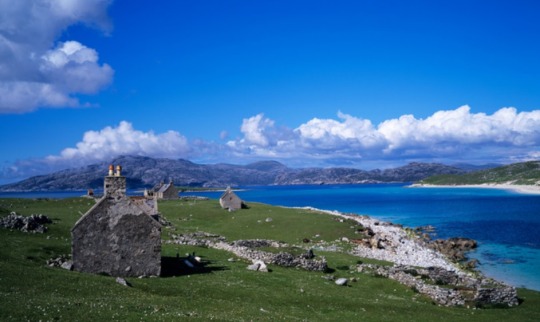

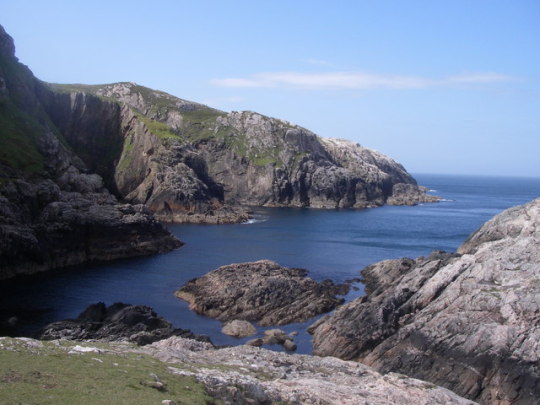
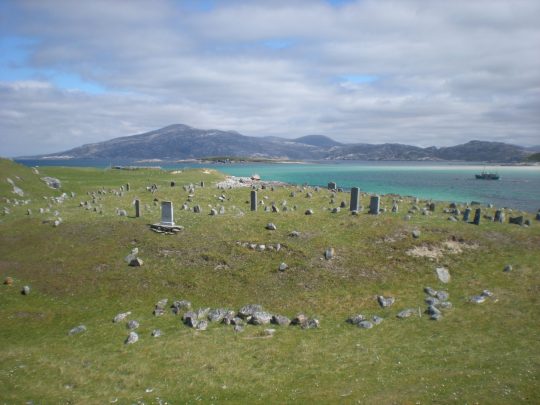

On December 2nd 1971 the last two permanently resident families leave the island of Scarp, off Harris in the Western Isles.
It was 52 years ago this week that the last native residents evacuated the island of Scarp with a family leaving on a small boat packed with furniture as their two cows swam behind them. The departure of Mr and Mrs Angus MacInnes and their two sons marked the end of an era on the island which was home to more than 200 people in the late 19th Century.
A newspaper report documented the exit of the MacInnes family, who came ashore half-a-mile away at Hushinish Beach on Harris before settling on a croft at Govig.
The article, printed in the Press and Journal, noted how the island was then “left to the Old Etonians” given its remaining residents were Andrew Miller Mundy, whose father once owned the North Harris Estate, and his school friend Andrew Cox, who temporarily moved to the island earlier that year with his wife and their baby, India.
After the MacInnes family left, life on Scarp continued for several more weeks until a heavy storm cut the island off with provisions running ‘dangerously low’. Mundy, in London at the time, sent a helicopter in to rescue his girlfriend, a model who he later married, with food also choppered into Scarp - just in time for Christmas.
Mundy later relocated permanently to Harris, trained himself to catch lobsters and worked the waters around St Kilda for a decade. He became a popular figure to many, representing Harris at council level for many years and was admired for his dedication to wildlife and conservation. Scarp, meanwhile, has seen little human life since the early 1970s. Those who inherited the island’s crofting rights still keep sheep on Scarp with rams taken over for tupping and lambs returned to Stornoway for sale in September.
The ruins of several old buildings remain scattered over the island with a handful of holiday homes bringing in visitors from time to time.
From a high of over 200 the population of Scarp was still a relatively healthy 100-150 at the turn of the 20th Century. The island is rocky and the north part is over 300m in height with a steep drop to the sea. The village, which is now in serious disrepair is located in the south-east corner where it is partly sheltered from the Atlantic winds. The only land capable of cultivation is near the village on the east coast. The local economy would have been very basic - potatoes, cabbages, oats, milk, fish. Billingsgate market in London would have been the destination for much of the lobster caught by the Scarp fishermen.
The village on Scarp had no electricity and the only means of illumination would have been oil lamps. There was piped water and the village did have a small shop. The telephone line was installed in 1947. Despite these few basic comforts Scarps population like so many other small islands around Scotland continued to decline. In 1966 the Church of Scotland refused to replace the lay preacher and a year later the village school closed. Two years later it was the Post Offices turn to close its doors for the last time and with it so ended all mail deliveries to and from the island.
As the islands infrastructure continued to deteriorate the next thing to go was the telephone cable. This was severed in a storm and the GPO simply refused to repair it. This was just about the last straw for the remaining islanders.
The people may have left but Scarp still gets mentioned in many a conversation to due the adventures of German rocket scientist Gerhard Zucher. The German boffin attempted to develop a rocket which could 'fire' mail from Scarp to Harris and vice versa. Unfortunately the first launch simply exploded on the spot. A second firing from Harris to Scarp was a success but the project was quickly forgotten....but still very much lingers in the legends and stories of Scarp.
Although there are no permanent residents, a handful of holiday homes still welcome visitors
37 notes
·
View notes
Text


Green Day American Idiot [20th Anniversary Edition Box Set] 2024 Reprise ——————————————————————— Tracks LP One: Original Album 01. American Idiot 02. Jesus of Suburbia I. Jesus of Suburbia II. City of the Damned III. I Don’t Care IV. Dearly Beloved V. Tales of Another Broken Home 03. Holiday 04. Boulevard of Broken Dreams 05. Are We the Waiting 06. St. Jimmy
Tracks LP Two: Original Album [continued] 07. Give Me Novacaine 08. She’s a Rebel 09. Extraordinary Girl 10. Letterbomb 11. Wake Me up When September Ends 12. Homecoming I. The Death of St. Jimmy II. East 12th St. III. Nobody Likes You IV. Rock and Roll Girlfriend V. We’re Coming Home Again 13. Whatsername
Tracks LP Three: B-Sides & Bonus Tracks 01. American Idiot [live] 02. Jesus of Suburbia [live] I. Jesus of Suburbia II. City of the Damned III. I Don’t Care IV. Dearly Beloved V. Tales of Another Broken Home 03. Holiday [live] 04. Are We the Waiting [live] 05. St. Jimmy [live] 06. Boulevard of Broken Dreams [live]
Tracks LP Four: B-Sides & Bonus Tracks [continued] 01. Favorite Son 02. Shoplifter 03. Governator 04. Too Much Too Soon 05. Are We the Waiting [VH1-Storytellers] 06. St. Jimmy [VH1-Storytellers] 07. Give Me Novacaine [VH1-Storytellers] 08. Homecoming [VH1-Storytellers]
Tracks LP Five: Demos 01. American Idiot 02. American Idiot [alternate version] 03. Jesus of Suburbia 04. Holiday • Boulevard of Broken Dreams 05. Are We We Are • St. Jimmy Opera 06. Novacaine 07. She’s a Rebel 08. Radio Baghdad
Tracks LP Six: Demos [continued] 01. Cluster Bomb 02. Wake Me up When September Ends 03. Homecoming (Nobody Likes You) 04. Everyone’s Breaking Down 05. Just Another Year 06. Lowlife 07. What’s Her Name
Tracks LP Seven: Live Irving Plaza, NYC, Sept 21, 2004 01. American Idiot 02. Jesus of Suburbia 03. Holiday 04. Boulevard of Broken Dreams 05. Are We the Waiting 06. St. Jimmy 07. Give Me Novacaine 08. She’s a Rebel 09. Extraordinary Girl (Live)
Tracks LP Eight: Live Irving Plaza, NYC, Sept 21, 2004 [continued] 01. Letterbomb 02. Wake Me up When September Ends 03. Homecoming 04. Whatsername 05. Minority 06. We Are the Champions
Tracks Blu-ray One: 01. Heart Like a Hand Grenade
Tracks Blu-ray Two: Documentary 01. 20 Years of American Idiot BBC Live 02. St. Jimmy 03. Give Me Novacaine 04. She’s a Rebel 05. Welcome to Paradise 06. Wake Me up When September Ends 07. Jesus of Suburbia 08. American Idiot 09. Boulevard of Broken Dreams ———————————————————————
Billie Joe Armstrong
Tré Cool
Mike Dirnt
* Long Live Rock Archive
#GreenDay#Green Day#Billie Joe Armstrong#Tre Cool#Mike Dirnt#American Idiot#Reissue#20th Anniversary#Box Set#Punk#2024
5 notes
·
View notes